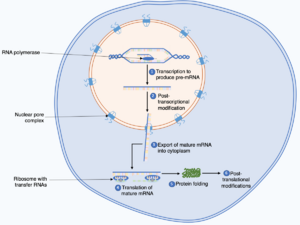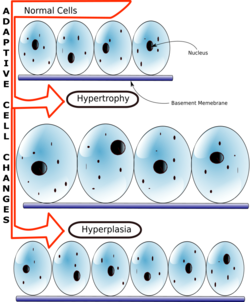Biology:Muscle hypertrophy

Muscle hypertrophy or muscle building involves a hypertrophy or increase in size of skeletal muscle through a growth in size of its component cells. Two factors contribute to hypertrophy: sarcoplasmic hypertrophy, which focuses more on increased muscle glycogen storage; and myofibrillar hypertrophy, which focuses more on increased myofibril size.[1] It is the primary focus of bodybuilding-related activities.
Hypertrophy stimulation
A range of stimuli can increase the volume of muscle cells. These changes occur as an adaptive response that serves to increase the ability to generate force or resist fatigue in anaerobic conditions.
Strength training

Strength training (resistance training) causes neural and muscular adaptations which increase the capacity of an athlete to exert force through voluntary muscular contraction: After an initial period of neuro-muscular adaptation, the muscle tissue expands by creating sarcomeres (contractile elements) and increasing non-contractile elements like sarcoplasmic fluid.[2]
Muscular hypertrophy can be induced by progressive overload (a strategy of progressively increasing resistance or repetitions over successive bouts of exercise to maintain a high level of effort).[3] However, the precise mechanisms are not clearly understood; currently accepted hypotheses involve some combination of mechanical tension, metabolic fatigue, and muscular damage.
Muscular hypertrophy plays an important role in competitive bodybuilding and strength sports like powerlifting, American football, and Olympic weightlifting.
Anaerobic training
The best approach to specifically achieve muscle growth remains controversial (as opposed to focusing on gaining strength, power, or endurance); it was generally considered that consistent anaerobic strength training will produce hypertrophy over the long term, in addition to its effects on muscular strength and endurance. Muscular hypertrophy can be increased through strength training and other short-duration, high-intensity anaerobic exercises. Lower-intensity, longer-duration aerobic exercise generally does not result in very effective tissue hypertrophy; instead, endurance athletes enhance storage of fats and carbohydrates within the muscles,[4] as well as neovascularization.[5][6]
Temporary swelling
During a workout, increased blood flow to metabolically active areas causes muscles to temporarily increase in size. This phenomenon is referred to as transient hypertrophy, or more commonly known as being "pumped up" or getting "a pump."[7] About two hours after a workout and typically for seven to eleven days, muscles swell due to an inflammation response as tissue damage is repaired.[8] Longer-term hypertrophy occurs due to more permanent changes in muscle structure.
Factors affecting hypertrophy
Biological factors (such as DNA and sex), nutrition, and training variables can affect muscle hypertrophy.[9]
Individual differences in genetics account for a substantial portion of the variance in existing muscle mass. A classical twin study design (similar to those of behavioral genetics) estimated that about 53% of the variance in lean body mass is heritable,[10] along with about 45% of the variance in muscle fiber proportion.[11]

During puberty in males, hypertrophy occurs at an increased rate. Natural hypertrophy normally stops at full growth in the late teens. As testosterone is one of the body's major growth hormones, on average, males find hypertrophy much easier (on an absolute scale) to achieve than females, and, on average, have about 60% more muscle mass than women.[12] Taking additional testosterone, as in anabolic steroids, will increase results. It is also considered a performance-enhancing drug, the use of which can cause competitors to be suspended or banned from competitions. Testosterone is also a medically regulated substance in most[13][14] countries, making it illegal to possess without a medical prescription. Anabolic steroid use can cause testicular atrophy, cardiac arrest,[15] and gynecomastia.[16]
In the long term, a positive energy balance, when more calories are consumed rather than burned, is helpful for anabolism and therefore muscle hypertrophy. An increased requirement for protein can help elevate protein synthesis, which is seen in athletes training for muscle hypertrophy. However, there is no scientific consensus on whether strength-training athletes have increased protein requirements.[17]
Training variables, in the context of strength training, such as frequency, intensity, and total volume also directly affect the increase of muscle hypertrophy. A gradual increase in all of these training variables will yield muscular hypertrophy.[18]
Changes in protein synthesis and muscle cell biology associated with stimuli
Protein synthesis

The message filters down to alter the pattern of gene expression. The additional contractile proteins appear to be incorporated into existing myofibrils (the chains of sarcomeres within a muscle cell). There appears to be some limit to how large a myofibril can become: at some point, they split. These events appear to occur within each muscle fiber. That is hypertrophy results primarily from the growth of each muscle cell rather than an increase in the number of cells. Skeletal muscle cells are however unique in the body in that they can contain multiple nuclei, and the number of nuclei can increase.[19]
Cortisol decreases amino acid uptake by muscle tissue, and inhibits protein synthesis.[20] The short-term increase in protein synthesis that occurs subsequent to resistance training returns to normal after approximately 28 hours in adequately fed male youths.[21] Another study determined that muscle protein synthesis was elevated even 72 hours following training.[22]
A small study performed on young and elderly found that ingestion of 340 grams of lean beef (90 g protein) did not increase muscle protein synthesis any more than ingestion of 113 grams of lean beef (30 g protein). In both groups, muscle protein synthesis increased by 50%. The study concluded that more than 30 g protein in a single meal did not further enhance the stimulation of muscle protein synthesis in young and elderly.[23] However, this study didn't check protein synthesis in relation to training; therefore conclusions from this research are controversial. A 2018 review of the scientific literature[24] concluded that for the purpose of building lean muscle tissue, a minimum of 1.6 g protein per kilogram of body weight is required, which can for example be divided over 4 meals or snacks and spread out over the day.[citation needed]
It is not uncommon for bodybuilders to advise a protein intake as high as 2–4 g per kilogram of bodyweight per day.[25] However, scientific literature has suggested this is higher than necessary, as protein intakes greater than 1.8 g per kilogram of body weight showed to have no greater effect on muscle hypertrophy.[26] A study carried out by American College of Sports Medicine (2002) put the recommended daily protein intake for athletes at 1.2–1.8 g per kilogram of body weight.[26][27][28] Conversely, Di Pasquale (2008), citing recent studies, recommends a minimum protein intake of 2.2 g/kg "for anyone involved in competitive or intense recreational sports who wants to maximize lean body mass but does not wish to gain weight. However athletes involved in strength events (..) may need even more to maximize body composition and athletic performance. In those attempting to minimize body fat and thus maximize body composition, for example in sports with weight classes and in bodybuilding, it's possible that protein may well make up over 50% of their daily caloric intake."[29]
Microtrauma

Microtrauma is tiny damage to the muscle fibers. The precise relation between microtrauma and muscle growth is not entirely understood yet.[citation needed]
One theory is that microtrauma plays a significant role in muscle growth.[30][31] When microtrauma occurs (from weight training or other strenuous activities), the body responds by overcompensating, replacing the damaged tissue and adding more, so that the risk of repeat damage is reduced. Damage to these fibers has been theorized as the possible cause for the symptoms of delayed onset muscle soreness (DOMS), and is why progressive overload is essential to continued improvement, as the body adapts and becomes more resistant to stress.
However, other work examining the time course of changes in muscle protein synthesis and their relationship to hypertrophy showed that damage was unrelated to hypertrophy.[32] In fact, in one study[32] the authors showed that it was not until the damage subsided that protein synthesis was directed to muscle growth.
Myofibrillar vs. sarcoplasmic hypertrophy
This article's factual accuracy is disputed. (May 2017) (Learn how and when to remove this template message) |

In the bodybuilding and fitness community and even in some academic books skeletal muscle hypertrophy is described as being in one of two types: Sarcoplasmic or myofibrillar.[qualify evidence] According to this hypothesis, during sarcoplasmic hypertrophy, the volume of sarcoplasmic fluid in the muscle cell increases with no accompanying increase in muscular strength, whereas during myofibrillar hypertrophy, actin and myosin contractile proteins increase in number and add to muscular strength as well as a small increase in the size of the muscle. Sarcoplasmic hypertrophy is greater in the muscles of bodybuilders because studies suggest sarcoplasmic hypertrophy shows a greater increase in muscle size while myofibrillar hypertrophy proves to increase overall muscular strength making it more dominant in Olympic weightlifters.[33] These two forms of adaptations rarely occur completely independently of one another; one can experience a large increase in fluid with a slight increase in proteins, a large increase in proteins with a small increase in fluid, or a relatively balanced combination of the two.
In sports
Examples of increased muscle hypertrophy are seen in various professional sports, mainly strength related sports such as boxing, olympic weightlifting, mixed martial arts, rugby, professional wrestling and various forms of gymnastics. Athletes in other more skill-based sports such as basketball, baseball, ice hockey, and football may also train for increased muscle hypertrophy to better suit their position of play. For example, a center (basketball) may want to be bigger and more muscular to better overpower his or her opponents in the low post.[34] Athletes training for these sports train extensively not only in strength but also in cardiovascular and muscular endurance training.[citation needed]
Pathology
Some neuromuscular diseases result in true hypertrophy of one or more skeletal muscles, confirmed by MRI or muscle biopsy. As this muscle hypertrophy is not the result of resistance training nor heavy manual labour, this is why the muscle hypertrophy is described as a pseudoathletic appearance.
As muscle hypertrophy is a response to strenuous anaerobic activity, ordinary everyday activity would become strenuous in diseases that result in premature muscle fatigue (neural or metabolic), or disrupt the excitation-contraction coupling in muscle, or cause repetitive or sustained involuntary muscle contractions (fasciculations, myotonia, or spasticity).[35][36] In lipodystrophy, an abnormal deficit of subcutaneous fat accentuates the appearance of the muscles, though the muscles are quantifiably hypertrophic (possibly due to a metabolic abnormality).[37][38]
Diseases that result in true muscle hypertrophy include, but not limited to, select: muscular dystrophies, metabolic myopathies, endocrine myopathies, congenital myopathies, non-dystrophic myotonias and pseudomyotonias, denervation, spasticity, and lipodystrophy. The muscle hypertrophy may persist throughout the course of the disease, or may later atrophy, or become pseudohypertrophic (muscle atrophy with infiltration of fat or other tissue). For instance, Duchenne and Becker muscular dystrophy may start as true muscle hypertrophy, but later develop into pseudohypertrophy.[39]
See also
- Anabolism
- Colorado Experiment
- Davis' law
- Follistatin
- Lean body mass
- Muscle atrophy
- Muscle dystrophy
- Myostatin
- Pseudoathletic appearance
- Pseudohypertrophy
References
- ↑ Baechle, Thomas R.; Earle, Roger W., eds (2008). Essentials of strength training and conditioning (3rd ed.). Champaign, IL: Human Kinetics. ISBN 978-0-7360-5803-2.[page needed]
- ↑ Schoenfeld, Brad (2016). Science and Development of Muscle Hypertrophy. Human Kinetics. pp. 1–15. ISBN 978-1-4925-1960-7.
- ↑ "Early skeletal muscle hypertrophy and architectural changes in response to high-intensity resistance training". Journal of Applied Physiology 102 (1): 368–73. January 2007. doi:10.1152/japplphysiol.00789.2006. PMID 17053104.
- ↑ "Increased intramuscular lipid storage in the insulin-resistant and endurance-trained state". Pflügers Archiv 451 (5): 606–16. February 2006. doi:10.1007/s00424-005-1509-0. PMID 16155759.
- ↑ "Effects of training on muscle capillary pattern: intermittent vs continuous exercise". The Journal of Sports Medicine and Physical Fitness 32 (2): 123–7. June 1992. PMID 1279273.
- ↑ "What makes vessels grow with exercise training?". Journal of Applied Physiology 97 (3): 1119–28. September 2004. doi:10.1152/japplphysiol.00035.2004. PMID 15333630.
- ↑ Joseph Eitel. "What Causes Your Muscles to Expand When You Work Out?". http://woman.thenest.com/causes-muscles-expand-work-out-6597.html.
- ↑ Claire Lunardoni (January 22, 2010). "Why Do You Swell After Workout?". http://www.livestrong.com/article/75670-swell-after-workout/.
- ↑ "How do muscles grow?". https://www.unm.edu/~lkravitz/Article%20folder/musclesgrowLK.html.
- ↑ Arden, N. K. and Spector, T. D. (1997), Genetic Influences on Muscle Strength, Lean Body Mass, and Bone Mineral Density: A Twin Study. J Bone Miner Res, 12: 2076-2081. doi:10.1359/jbmr.1997.12.12.2076
- ↑ "Genetic determinism of fiber type proportion in human skeletal muscle". FASEB Journal 9 (11): 1091–5. August 1995. doi:10.1096/fasebj.9.11.7649409. PMID 7649409.
- ↑ "Gender differences in strength and muscle fiber characteristics". European Journal of Applied Physiology and Occupational Physiology 66 (3): 254–62. 1993. doi:10.1007/BF00235103. PMID 8477683.
- ↑ "Search National Drug Schedule - NAPRA". http://napra.ca/pages/Schedules/Search.aspx.
- ↑ "Controlled Substances Act". https://www.fda.gov/RegulatoryInformation/Legislation/ucm148726.htm.
- ↑ "Sudden cardiac death during anabolic steroid abuse: morphologic and toxicologic findings in two fatal cases of bodybuilders". International Journal of Legal Medicine 121 (1): 48–53. January 2007. doi:10.1007/s00414-005-0055-9. PMID 16292586.
- ↑ "Androgen abuse in athletes: detection and consequences". The Journal of Clinical Endocrinology and Metabolism 95 (4): 1533–43. April 2010. doi:10.1210/jc.2009-1579. PMID 20139230.
- ↑ "Protein requirements and supplementation in strength sports". Nutrition 20 (7–8): 689–95. July 2004. doi:10.1016/j.nut.2004.04.009. PMID 15212752. https://www.researchgate.net/publication/8494999. Retrieved May 15, 2017.
- ↑ "The influence of frequency, intensity, volume and mode of strength training on whole muscle cross-sectional area in humansq". Sports Medicine 37 (3): 225–64. March 1, 2007. doi:10.2165/00007256-200737030-00004. PMID 17326698.
- ↑ "Myonuclei acquired by overload exercise precede hypertrophy and are not lost on detraining". Proceedings of the National Academy of Sciences of the United States of America 107 (34): 15111–6. August 2010. doi:10.1073/pnas.0913935107. PMID 20713720. Bibcode: 2010PNAS..10715111B.
- ↑ Manchester KL (1970). "33 – Sites of Hormonal Regulation of Protein Metabolism". Mammalian Protein Metabolism. Academic Press, New York. p. 229. doi:10.1016/B978-0-12-510604-7.50011-6. ISBN 978-0-12-510604-7. https://archive.org/details/mammalianprotein0000munr.
- ↑ "Resistance training alters the response of fed state mixed muscle protein synthesis in young men". American Journal of Physiology. Regulatory, Integrative and Comparative Physiology 294 (1): R172-8. January 2008. doi:10.1152/ajpregu.00636.2007. PMID 18032468.
- ↑ "Coordinated collagen and muscle protein synthesis in human patella tendon and quadriceps muscle after exercise". The Journal of Physiology 567 (Pt 3): 1021–33. September 2005. doi:10.1113/jphysiol.2005.093690. PMID 16002437.
- ↑ "A moderate serving of high-quality protein maximally stimulates skeletal muscle protein synthesis in young and elderly subjects". Journal of the American Dietetic Association 109 (9): 1582–6. September 2009. doi:10.1016/j.jada.2009.06.369. PMID 19699838.
- ↑ "How much protein can the body use in a single meal for muscle-building? Implications for daily protein distribution". Journal of the International Society of Sports Nutrition 15 (1): 10. February 27, 2018. doi:10.1186/s12970-018-0215-1. PMID 29497353.
- ↑ "Bodybuilders and Protein – Part 2". Leehayward.com. http://www.leehayward.com/protein_part2.htm.
- ↑ 26.0 26.1 "Evaluation of protein requirements for trained strength athletes". Journal of Applied Physiology 73 (5): 1986–95. November 1992. doi:10.1152/jappl.1992.73.5.1986. PMID 1474076.
- ↑ "Weight loss and gain in athletes". Current Sports Medicine Reports 1 (4): 208–13. August 2002. doi:10.1249/00149619-200208000-00004. PMID 12831697.
- ↑ "Effect of exercise on protein requirements". Journal of Sports Sciences 9 Spec No: 53–70. 1991. doi:10.1080/02640419108729866. PMID 1895363.
- ↑ Di Pasquale, Mauro G. (2008). "Use of Proteins in Energy Metabolism". in Ira Wolinsky, Judy A. Driskell. Sports Nutrition: Energy metabolism and exercise. CRC Press. p. 79. ISBN 978-0-8493-7950-5.
- ↑ "Cellular and molecular regulation of muscle regeneration". Physiological Reviews 84 (1): 209–38. January 2004. doi:10.1152/physrev.00019.2003. PMID 14715915.
- ↑ "How Do Muscles Grow?". http://www.unm.edu/~lkravitz/Article%20folder/musclesgrowLK.html.
- ↑ 32.0 32.1 "Resistance training-induced changes in integrated myofibrillar protein synthesis are related to hypertrophy only after attenuation of muscle damage". The Journal of Physiology 594 (18): 5209–22. September 2016. doi:10.1113/JP272472. PMID 27219125.
- ↑ Kraemer, William J.; Zatsiorsky, Vladimir M. (2006). Science and practice of strength training. Champaign, IL: Human Kinetics. p. 50. ISBN 978-0-7360-5628-1. https://books.google.com/books?id=QWSn4iKgNo8C&pg=PA50.
- ↑ Khorshidi, Eldon (September 10, 2012). "Chris Bosh Gaining Weight to Play Center". SLAM. http://www.slamonline.com/nba/chris-bosh-gaining-weight-to-play-center/#5LUvmeqjg2V5wykA.97.
- ↑ Walters, Jon (October 2017). "Muscle hypertrophy and pseudohypertrophy". Practical Neurology 17 (5): 369–379. doi:10.1136/practneurol-2017-001695. ISSN 1474-7766. PMID 28778933.
- ↑ Nadaj-Pakleza, Aleksandra (2022-07-01). "Muscle hypertrophy: indicative of good health or disease? / Hypertrophie musculaire: signe de bonne santé ou de maladie ?" (in fr, en). Les Cahiers de Myologie (25): 10–15. doi:10.1051/myolog/202225004. ISSN 2108-2219. https://www.cahiers-myologie.org/articles/myolog/abs/2022/01/myolog202225p10/myolog202225p10.html.
- ↑ Ji, Hongzhao; Weatherall, Paul; Adams-Huet, Beverley; Garg, Abhimanyu (August 2013). "Increased skeletal muscle volume in women with familial partial lipodystrophy, Dunnigan variety". The Journal of Clinical Endocrinology and Metabolism 98 (8): E1410–1413. doi:10.1210/jc.2013-1297. ISSN 1945-7197. PMID 23783098.
- ↑ El-Darouti, Mohammad Ali; Al-Ali, Faiza Mohamed (2019), El-Darouti, Mohammad Ali; Al-Ali, Faiza Mohamed, eds., "Loss of Subcutaneous Fat, Muscle Hypertrophy, Diabetes and Hyperlipidemia" (in en), Challenging Cases in Dermatology Volume 2: Advanced Diagnoses and Management Tactics (Cham: Springer International Publishing): pp. 7–11, doi:10.1007/978-3-030-21855-3_2, ISBN 978-3-030-21855-3, https://doi.org/10.1007/978-3-030-21855-3_2, retrieved 2023-10-12
- ↑ Kornegay, Joe N.; Childers, Martin K.; Bogan, Daniel J.; Bogan, Janet R.; Nghiem, Peter; Wang, Jiahui; Fan, Zheng; Howard, James F. et al. (February 2012). "The paradox of muscle hypertrophy in muscular dystrophy". Physical Medicine and Rehabilitation Clinics of North America 23 (1): 149–172, xii. doi:10.1016/j.pmr.2011.11.014. ISSN 1558-1381. PMID 22239881.
Further reading
- "Akt/mTOR pathway is a crucial regulator of skeletal muscle hypertrophy and can prevent muscle atrophy in vivo". Nature Cell Biology 3 (11): 1014–9. November 2001. doi:10.1038/ncb1101-1014. PMID 11715023.
- "Muscle hypertrophy response to resistance training in older women". Journal of Applied Physiology 70 (5): 1912–6. May 1991. doi:10.1152/jappl.1991.70.5.1912. PMID 1864770.
- "Muscle hypertrophy in men and women". Medicine and Science in Sports and Exercise 20 (4): 338–44. August 1988. doi:10.1249/00005768-198808000-00003. PMID 3173042.
- "Strength conditioning in older men: skeletal muscle hypertrophy and improved function". Journal of Applied Physiology 64 (3): 1038–44. March 1988. doi:10.1152/jappl.1988.64.3.1038. PMID 3366726.
- "Signalling pathways that mediate skeletal muscle hypertrophy and atrophy". Nature Cell Biology 5 (2): 87–90. February 2003. doi:10.1038/ncb0203-87. PMID 12563267.
- "Skeletal muscle hypertrophy and atrophy signaling pathways". The International Journal of Biochemistry & Cell Biology 37 (10): 1974–84. October 2005. doi:10.1016/j.biocel.2005.04.018. PMID 16087388.
- "Myostatin mutation associated with gross muscle hypertrophy in a child". The New England Journal of Medicine 350 (26): 2682–8. June 2004. doi:10.1056/NEJMoa040933. PMID 15215484.
 |

